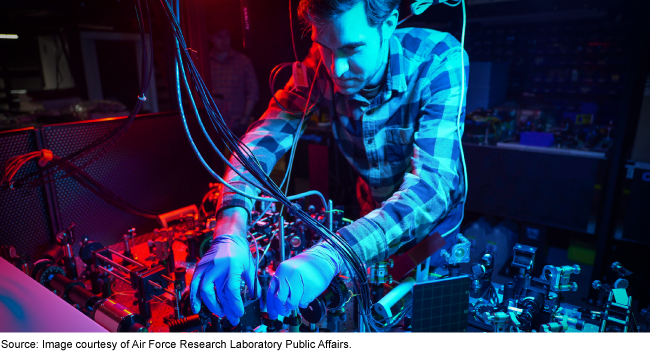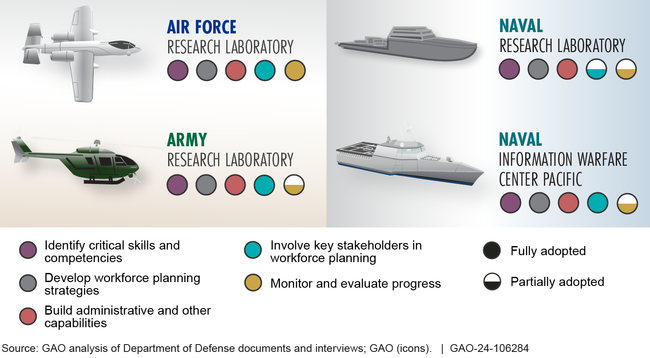Quantum Technologies: Defense Laboratories Should Take Steps to Improve Workforce Planning
Fast Facts
Quantum technologies build on quantum physics to process and communicate information in ways that existing technologies can't. Nations leading quantum research and development may have an edge in cryptography and computing—which are critical to national security.
DOD has created multiple pathways to recruit highly specialized staff in physics, chemistry, and math and followed leading practices to build its quantum workforce. But some defense laboratories haven't fully adopted all practices. For example, Army and Navy don't consistently measure progress toward their workforce goals.
We recommended addressing these workforce planning issues.
Air Force Research Laboratory scientists work on quantum communication and networking

Highlights
What GAO Found
In fiscal year 2023, seven defense laboratories reported 255 staff working all or part of their time on quantum projects. Most of these quantum workers had PhDs, were either physicists or engineers, and were a mix of mostly federal civilian employees and some contractors. Consistent with DOD's priority to expand the quantum workforce beyond the field of physics, these laboratories also had specialists from fields such as chemistry, computer science, and mathematics.
The four defense laboratories conducting most of DOD's quantum work included quantum information science as part of their broader strategic workforce planning but varied in their adoption of five leading practices (see figure). One laboratory fully adopted all five, while three laboratories conducted workforce planning that was aligned with most but not all leading practices. Three laboratories did not fully adopt the leading practice of monitoring and evaluating progress because their strategic workforce plans either did not have performance measures or inconsistently applied them. One laboratory also did not fully adopt the leading practice of involving key stakeholders in workforce planning because it did not have a means to communicate its workforce goals, initiatives, and metrics for success. Better workforce planning could help these laboratories build and retain the workforce needed to maintain global leadership in quantum technologies.
Defense Laboratories' Adoption of Leading Practices for Strategic Workforce Planning

According to GAO's questionnaire results, 41 DOD science, technology, engineering, and mathematics (STEM) education programs contributed to quantum workforce development from fiscal years 2019 through 2023. Through these programs, at least 423 students and postdoctoral researchers gained quantum work experience at defense laboratories. These programs also reported developing students through exposure to DOD quantum research, postdoctoral research funding, and training in a variety of STEM disciplines that can feed into the quantum workforce, such as physics, engineering, and computer science.
Why GAO Did This Study
DOD considers quantum technologies as critical to protecting national security. Nations that lead in quantum technologies can gain a competitive edge in areas such as cryptography, sensing, and computing. To remain competitive, DOD is developing its quantum workforce.
A Senate report included a provision for GAO to review DOD's quantum workforce planning and workforce development activities. This report examines (1) the size and composition of the quantum workforce at defense laboratories that conduct quantum research and development, (2) the extent to which the primary defense laboratories conducting this research and development followed leading practices for strategic workforce planning, and (3) how DOD's STEM education programs have contributed to quantum workforce development and the extent to which DOD has monitored these contributions.
GAO analyzed defense laboratories' workforce data and workforce planning activities, compared workforce planning activities to GAO leading practices for strategic workforce planning, and administered a questionnaire to 86 DOD STEM education programs. GAO received responses from 59 programs.
Recommendations
This report includes four recommendations for the defense laboratories to fully adopt leading practices for strategic workforce planning. DOD concurred with all four recommendations.
Recommendations for Executive Action
| Agency Affected | Recommendation | Status |
|---|---|---|
| Department of the Army | The Secretary of the Army should direct the Commander of ARL to fully adopt the leading practice of monitoring and evaluating progress toward human capital goals and programmatic results by developing performance measures tailored to its mission needs. (Recommendation 1) |
When we confirm what actions the agency has taken in response to this recommendation, we will provide updated information.
|
| Department of the Navy | The Secretary of the Navy should direct the Commander of NIWC Pacific to fully adopt the leading practice of monitoring and evaluating progress toward human capital goals and programmatic results by developing performance measures for evaluating success across the center. (Recommendation 2) |
When we confirm what actions the agency has taken in response to this recommendation, we will provide updated information.
|
| Department of the Navy | The Secretary of the Navy should direct the Commander of NRL to fully adopt the leading practice of involving top management, employees, and other stakeholders in workforce planning by developing and implementing an enterprise-wide strategic workforce plan or otherwise communicating its workforce goals, initiatives, and metrics for evaluating success throughout the laboratory. (Recommendation 3) |
When we confirm what actions the agency has taken in response to this recommendation, we will provide updated information.
|
| Department of the Navy | The Secretary of the Navy should direct the Commander of NRL to fully adopt the leading practice of monitoring and evaluating progress toward human capital goals and programmatic results by developing performance measures for evaluating success. (Recommendation 4) |
When we confirm what actions the agency has taken in response to this recommendation, we will provide updated information.
|
